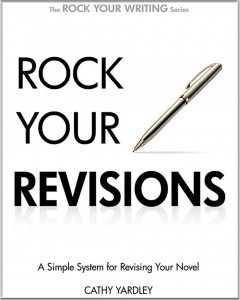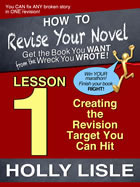[Bill Denise] Adventures in Revision
Hello, I’m back with the second part of my story:
Revision.
I was much happier when I didn’t understand what it meant.
After I finished my novel, I went back to the beginning and started reading and editing my work. I was fixing bad sentences, correcting the grammar and punctuation that I could find, and generally cleaning things up.
GREAT! Right?
Nope. Not great. Not at all.
It’s not that the things I was doing were wrong or bad, but at best they were out of order. Luckily I dropped a note to Tami and she set me on the right path. She told me that I needed a strategy for revision, much like I needed planning for my novel.
I did NOT like the sound of this. MORE PLANNING?!?
I wanted to burn through the manuscript, fix what I could and then drop it on some unsuspecting readers to help me find any problems with the story itself. Now I discover that there is even more work involved – more preparation before I can start revising my work? BAH!
And to make things worse: this time Tami did not have an excellent series of blog posts to teach me the method, I needed to find it elsewhere.
I started with Holly Lisle’s course How To Revise Your Novel (HTRYN). For those of you unfamiliar with the course, it is extremely detailed and absolutely FULL of wonderful tools to help you with the revision. The most important thing is this: it teaches you to go through your story start to finish to find things that are not working in the big picture. This sounds so small, but really it is soooo BIG. It is much, much more than correcting grammar and making sentences flow better. I was analyzing characters, plotlines, settings, and scenery at a level of detail I’d not seen since I was deep into worldbuilding. I’m not going to try and explain how and why here because, well, I couldn’t. Suffice it to say, her course probably covers every possible tool you could ever need to fix a novel.
 I also referred to Cathy Yardley’s excellent little book Rock Your Revisions. This book is focused more on the process of revision, and as I tried to write my own summary of it, I found that the author said it best in her introduction: “…a simple, systematic approach to identifying what needs fixing in a manuscript, [followed by] a scene-by-scene revision plan..” I really liked her approach to the process, even though she did not provide as many tools as HTRYN.
I also referred to Cathy Yardley’s excellent little book Rock Your Revisions. This book is focused more on the process of revision, and as I tried to write my own summary of it, I found that the author said it best in her introduction: “…a simple, systematic approach to identifying what needs fixing in a manuscript, [followed by] a scene-by-scene revision plan..” I really liked her approach to the process, even though she did not provide as many tools as HTRYN.
For me, Rock was a breath of fresh air. While going through HTRYN, I often felt lost and disconnected from the overall plan. This is purely a personal-preference thing, due to my nature.
Perhaps I should explain…
If I’m putting something together, I’m the type of person who reads through all the instructions before I start.
When driving somewhere new, I read all of the turns and look at the big map before following turn-by-turn directions (This drives my wife crazy when she’s reading me directions in transit: Me: “what’s the next turn?” Her: “30 miles then take a right” Me: “and then what?” Her: [some variation of] “WHO CARES!?! IT’S 30 MILES AWAY AND YOU’LL ASK AGAIN WHEN WE GET THERE!” and she’s right, of course, but I can’t help it.)
In short, I’m crazy I want to see the big picture, the destination, the final product BEFORE I start working from step 1. Therefore, Cathy’s explanation of the system made me much more comfortable during the whole process.
Both of the revision methods are very good, and you’ll have to decide which one suits your way of thinking. The most important lesson I learned was that revision is HARD, and it’s not as much fun as writing in the first place.
After using the big picture tools to determine what grand themes needed to be fixed, I read through the novel again, keeping these big ideas in the front of my thoughts. I made notes every time I found something out of line with the big picture.
Finally, I started writing-in the changes. I did this on a scene-by-scene basis, collecting the notes for everything involved in the current scene: sets, characters, props, plots, themes, etc. Armed with all of these notes, I could see where details, both big and small, had to be changed. The revision plan gave me the tools to reach the final destination using scene-by-scene guidance.
 In the middle of my revision, I found that I had a whole lot of notes and no good way to organize them. So, being the geek that I am, I decided I needed a database to track them all! I developed a tool that I think is very helpful in this respect, which I cleverly named the Novel Revision Database. I won’t go into all the details here (possibly in another post, if Tami doesn’t banish me) but it allows you to take notes by subject, character, set, prop, plot, etc, or simply by page number as you read through your novel, and then using the magic of databases, it collects all of the relevant notes into the applicable scenes so you have them available as you revise scene-by-scene.
In the middle of my revision, I found that I had a whole lot of notes and no good way to organize them. So, being the geek that I am, I decided I needed a database to track them all! I developed a tool that I think is very helpful in this respect, which I cleverly named the Novel Revision Database. I won’t go into all the details here (possibly in another post, if Tami doesn’t banish me) but it allows you to take notes by subject, character, set, prop, plot, etc, or simply by page number as you read through your novel, and then using the magic of databases, it collects all of the relevant notes into the applicable scenes so you have them available as you revise scene-by-scene.
I’m still not done with my revision (did I mention it’s not really that much fun?), but I’m trying to knock it out in another couple of weeks. After it’s done I plan to send it to an editor and then self-publish. Once it’s done, I hope that Tami will let me advertise the fact on her blog.
Thank you for listening, I’ve enjoyed sharing my story with you. Feel free to contact me with any questions!
Related posts:
[Bill Denise] Adventures in Writing
Weekly Wordcount
Sketchbooks for Writers
Taven Moore's Blog
- Taven Moore's profile
- 5 followers




